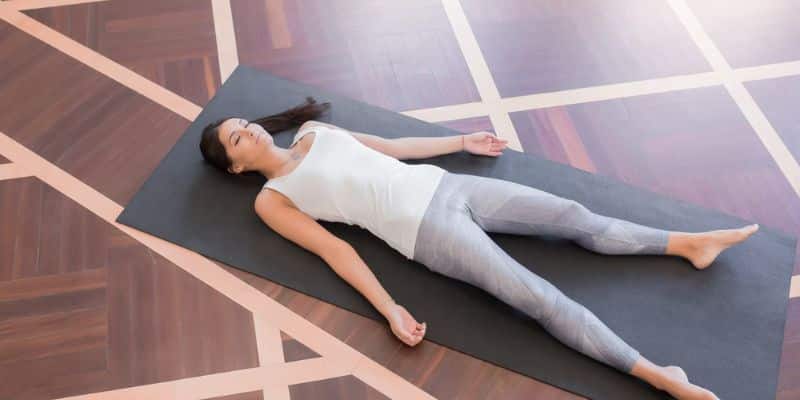What are the stages of yoga nidra
Yoga nidra is a practice readily accessible to anyone, with techniques tailored to specific needs, whether for hypertension or spiritual connection.
Find a quiet room, close the windows and doors, turn off any distractions, and lie down in Shavasana. Then, pop on a recording and listen to the soothing instructions. Follow along mentally without trying to concentrate or control your breath. The key to a successful yoga nidra session is maintaining awareness and avoiding sleep.
Pro tip: Keep your collar and tie loose for maximum relaxation. No snoozing allowed – you don’t want to miss out on the practice’s benefits!
1. Preparation/ Internalization
Yoga nidra is a form of meditation performed in Shavasana, where body limbs are separated to minimize touch sensations. To prevent contact between body parts and the floor, fingertips are turned upward. Loose clothing is recommended and the temperature kept moderate, free from any disturbance.
To keep the mind from wandering, focus on external sounds, moving from one to the other like a curious observer. This method of calming the mind is known as antar mouna. Eventually, the mind loses interest in the outside world and becomes quiet, preparing the mind and body for the practice of yoga nidra.
2. Resolve / Sankalpa
To choose a sankalpa, a statement used in yoga nidra, one must be deliberate and precise. Consider the following:
- I will awaken my spiritual potential
- I will become a positive force for others’ evolution
- I will excel in all endeavors
- I will be more efficient and aware
- I will achieve total health
Remember, choose only one that fits your desires. Don’t rush it; be patient. Once you’ve picked, stick with it, and don’t anticipate immediate results.
Depending on how heartfelt and sincere the goal is, time is required to plant it in the mind. Achieving one’s Sankalpa boils down to dedication and determination.
3. Rotation of consciousness / Body scan
Yoga Nidra’s rotation of consciousness is a powerful tool for cultivating deep awareness, but not everyone understands the right way to do it.
Unfortunately, some teachers don’t impart the full sequence, which needs to flow automatically and thoroughly from right thumb to left little toe, then back from left thumb to right little toe. Later circuits travel from head to heels, then back from facial features to legs.
But don’t worry about memorizing the sequence! Just keep your focus on three demands: stay alert, heed the voice, and mentally follow the instructions.
As you quickly visualize each body part on cue, you’ll soon be going deep into your subconscious mind, without even realizing it.
4. Awareness of the breath
Complete the rotations of consciousness and then draw your attention to your breath to achieve complete physical relaxation. No need to force or alter the breath; just maintain awareness of it. You can observe the breath in the nostrils, chest, or the passage between your navel and throat.
To deepen the relaxation, try counting the breaths mentally. Focusing on the breath not only enhances concentration and relaxation but also activates higher energies that flows through every cell in your body. This ignites pratyahara and aids in the upcoming practices to come.
5. Feeling and sensations / Opposites
In the next step of yoga nidra, you focus on emotions. You recall intense feelings and experience them fully before letting them go. To do this, you typically focus on opposite emotions, like hot and cold or joy and sorrow. This helps to balance your brain and control unconscious drives. It also develops emotional willpower and promotes relaxation by allowing you to release memories of deep emotions.
6. Visualization
In the final stage of yoga nidra, you’ll enter a state of mental relaxation. To get there, your instructor will guide you through visualizations of images like oceans, mountains, temples, and more, all of which hold deep symbolic significance. This helps bring your unconscious thoughts to the surface and lets you release any negative feelings or emotions you’ve been holding onto.
Over time, the practice of visualization leads to pure meditation and a deeper understanding of yourself. As you become more comfortable with visualizing, you’ll find distracting images fade away and your mind becomes clear and calm.
7. Closing the practice / Ending
After visualizing and feeling peace and calmness, yoga nidra ends with a positive resolution. This resolve is a conscious message to the unconscious mind, allowing for a positive shift in attitude and destiny. Stating the Sankalpa clearly and positively strengthens the mind and encourages a positive outlook.
Having faith in the power of the resolution reinforces its positive impact on the unconscious mind, bringing it to life in reality.
Finally, yoga nidra concludes by gradually arousing the mind from psychic sleep to the waking state.
General tips and suggestions
Yoga nidra is a relaxation technique you can do in class or at home. Find a quiet, comfortable spot without distractions. Semi-darkness is best for maintaining a state of relaxed awareness. Wear loose clothes and cover yourself with a thin blanket if you tend to get cold during relaxation.
Practice at the same time every day to get into a routine. Try doing it early in the morning or before bed for better sleep. If you’re coming home from work, take a five to ten-minute yoga nidra break to relax before continuing with your day.
It’s best to do yoga nidra on an empty stomach. If you must eat first, wait three hours after a heavy meal or half an hour after something light. If you tend to produce a lot of stomach acid, it’s okay to have a small snack. But if you don’t produce much, don’t eat at all.
Watch out for falling asleep during yoga nidra. If you’re feeling tired, take a cold shower first.
It’s better with a qualified teacher
Yoga nidra is a simple technique that can be learned from a recording. But it’s better for beginners to learn from an experienced teacher to gain a thorough understanding of the technique. Regular lessons combined with private practice using the same recording help students understand and remember the instructions effortlessly during deep relaxation.
An experienced teacher using a yoga nidra script can vary the practice based on the student’s needs, emphasizing relaxation for tense students and progressing towards meditation for those who relax easily. It is common to fall asleep during yoga nidra, but staying awake improves the practice.
If a teacher is not available, recordings of live classes can be a good alternative. However, it’s not recommended to instruct oneself until the entire practice is clear in the mind, as that can cause tension and interrupt the flow of the practice.
Optimize your session with preliminary Asanas
To optimize your yoga nidra practice, begin with yoga asanas to alleviate pain, tension, and stiffness in your body. For beginners, try a pawanmuktasana and shavasana sequence. More advanced practitioners can try out sarvangasana, halasana, matsyasana, paschimottanasana, bhujangasana, shalabhasana, or sirshasana.
If you want a shorter warm-up alternative, try six to twelve rounds of surya namaskara to loosen your joints and muscles and massage your internal organs. Practicing naukasana three to five times promotes general physical relaxation and prepares you for yoga nidra.
Shavasana is the ideal position
For yoga nidra, lie down on a blanket or mat with legs slightly apart and hands relaxed above the body. Try to avoid a pillow, but if you need one, use a thin one under the head. Keep the spine straight. If your lower back hurts, use a small pillow for support. Shavasana is the ideal position for yoga nidra, but you can also do it sitting or standing. If you tend to fall asleep during the practice, it’s better to practice in a standing position.
You can adapt the speed and content
Yoga Nidra instructions should be given at a pace that engages the mind, allowing it to understand and execute each step as it is guided. The speed may vary based on practice level and mental state. Rapid succession of consciousness rotation and images help keep the mind moving, avoiding fixed attention on any one subject. Precise, quickly-indicated visualization objects are also recommended.
For children, a rapid sequence of inner visualizations, including numbers, colors, forms, and natural scenes, will work well.
The ultimate goal of Yoga Nidra is improving perceptive ability, ideally with immediate recognition of called-out objects or images. It’s best to change the duration or content of practice to suit one’s capacity, rather than modifying the guidance speed.
Tips for ensuring a successful practice
Don’t go too deep
When practicing yoga nidra, don’t force yourself to go too deep. It’s important to stay relaxed and peaceful. Distractions are actually helpful, as they keep you alert and prevent you from falling asleep. Even if you experience tension due to sickness or mental disturbances, don’t worry. It’s normal and temporary. Keep practicing and you’ll feel better soon.
Increase your awareness gradually
If you feel restless or uncomfortable, adjust your position or even rest for a bit. Be mindful of the images you visualize during yoga nidra, as they can trigger negative emotions. Some may evoke fear of things like falling, drowning, or being hurt. If that happens, reassure yourself and try a different image. Remember that practicing yoga nidra should increase your awareness gradually, not overwhelm you.
Let go of negative thoughts
During practice, if negative thoughts or images disturb you, remember that they’re just expressing mental toxins looking for an outlet. Let them pass, and over time, negativity will fade away, and calm will prevail. With advanced practices, you may reach deep relaxation or meditation. To bring your mind out of a deep state, do so gradually, as a swift transition to waking consciousness can cause headaches or frighten some. If you experience either, focus on deep breaths while lying down in shavasana. It’s vital that teachers don’t judge a student’s experience as positive or negative, but validate all experiences.
Final Thoughts
Overall, the practice of yoga nidra is a form of relaxation that anybody can try if you’re looking for a restorative exercise routine. With its peaceful breathwork and visualizations, it can give our minds a much-needed break from the hustle and bustle of day-to-day life.
Following the stages outlined in this article, taking your time with each step and creating an inviting space to practice are key components to succeeding in your yoga nidra journey.
And don’t forget- have fun! If you’re feeling overwhelmed at any point during your yoga nidra practice, take a deep breath and remind yourself that you are worth the effort and time; love yourself first before anything else.


![Free Guided Meditation Scripts [PDF]](https://guidedmeditationscript.com/wp-content/uploads/2023/05/Guided-Meditation-Scripts-300x185.jpg)
![Free Visualization & Guided Imagery Scripts [PDF]](https://guidedmeditationscript.com/wp-content/uploads/2023/04/Visualization-Guided-Imagery-Scripts-300x185.jpg)
![Free Yoga Nidra Scripts [PDF]](https://guidedmeditationscript.com/wp-content/uploads/2023/04/Guided-Yoga-Nidra-Scripts-300x185.jpg)


